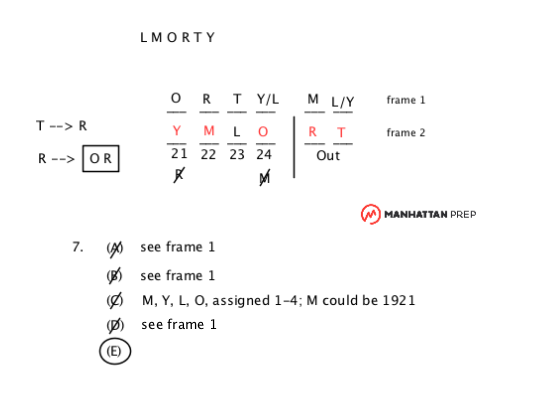
LSAT Forum
3 postsPage 1 of 1
-

- ManhattanPrepLSAT1
-
Thanks Received: 1909
-
Atticus Finch

- Posts: 2851
- Joined: October 07th, 2009
-

- ohthatpatrick
-
Thanks Received: 3808
-
Atticus Finch

- Posts: 4661
- Joined: April 01st, 2011
Re: Q7
The rule isn't saying "L and T are forced to be in that spot or nowhere else."
It's saying "that spot is forced to be L or T, and no one else".
Once you put T in 1923, L could theoretically go anywhere.
Or once you put L in 1923, T could theoretically go anywhere.
(if we're only talking about the implications of that rule)
In terms of what you're asking about (B), sure ... O could be in 1921 and then M could be in 1922.
But we're doing a must be true question so we have no interest in testing whether these ideas are possible.
We only care if these ideas are avoidable or mandatory.
On Must Be True, you never test what the answer is saying. You test whether a counterexample is possible, so the previous explanation was listing where we could find counterexamples to disprove that A/B/C/D force M to be in 1922.
Only (E) will FORCE M to be there. All the other answers provide starting points that let us still put M somewhere else.
Hope this helps.
It's saying "that spot is forced to be L or T, and no one else".
Once you put T in 1923, L could theoretically go anywhere.
Or once you put L in 1923, T could theoretically go anywhere.
(if we're only talking about the implications of that rule)
In terms of what you're asking about (B), sure ... O could be in 1921 and then M could be in 1922.
But we're doing a must be true question so we have no interest in testing whether these ideas are possible.
We only care if these ideas are avoidable or mandatory.
On Must Be True, you never test what the answer is saying. You test whether a counterexample is possible, so the previous explanation was listing where we could find counterexamples to disprove that A/B/C/D force M to be in 1922.
Only (E) will FORCE M to be there. All the other answers provide starting points that let us still put M somewhere else.
Hope this helps.
3 posts Page 1 of 1
